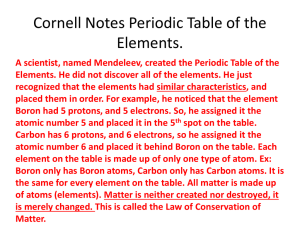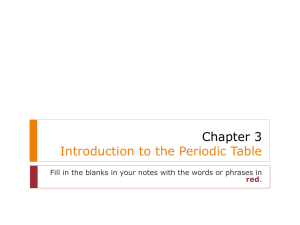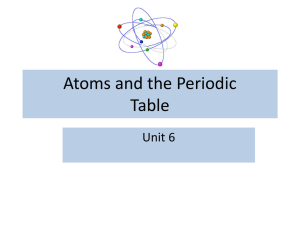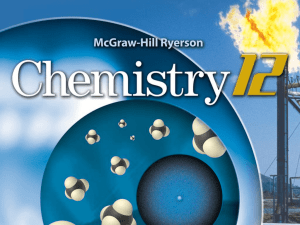Atomic Structure
advertisement
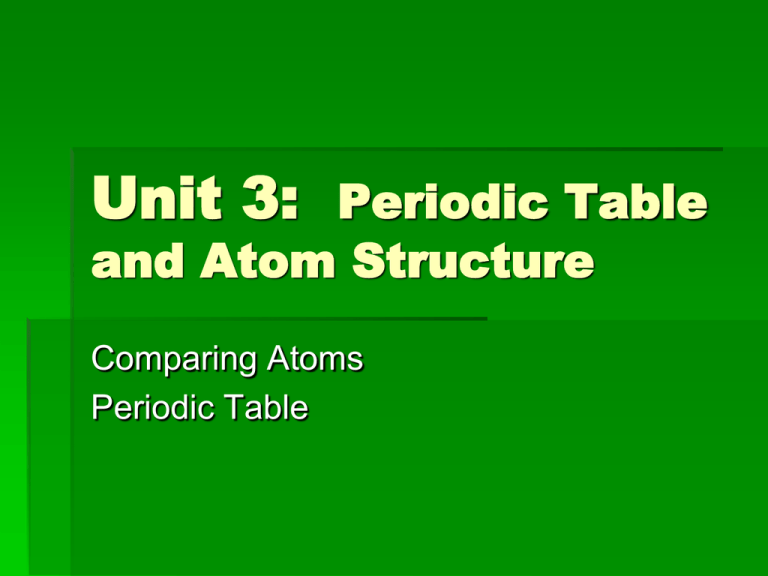
Unit 3: Periodic Table and Atom Structure Comparing Atoms Periodic Table Reading the Periodic Table What information is shown? Atomic Mass Atomic Number Element Symbol Element Name Periodic Table Atomic Number Element Name 47 Ag Silver 107.87 Atomic Mass Element Symbol Which is which? Periodic Table Atomic Number Element Name 47 Ag Silver 107.87 Atomic Mass Element Symbol Atomic Number Number of Protons What happens if you change the number of protons? Change the element HUGE amounts of energy to add or remove. Periodic Table Atomic Number 47 Ag Silver 107.87 Atomic Mass Protons & Neutrons Increase by amounts > 1 Different # of Neutrons in nucleus. Neutrons don’t change charge of atom Isotopes Atoms with different amounts of neutrons. A# 1 1 1 M# 1 2 3 + - 0 + - 0 +0 - Hydrogen- Hydrogen - Hydrogen- proteium deuterium tritium Periodic Table 47 Ag Silver 107.87 Atomic Mass # 0f Neutrons? Atomic Mass – Atomic Number 47 -47 Ag Silver 107.87 108 61 Neutrons Periodic Table Atomic Number 47 Element Symbol Ag Element Name Silver 107.87 Atomic Mass Electrons ? Equal to the Protons Electron Cloud Never in the same place “Buzzing” Arranged in energy levels Electron Levels Distance from nucleus increases energy . Electron Levels The higher the level the more electrons it can hold. Electron Levels Orbitals 18 18 8 8 2 We are only concerned with 8 per level •Period or row # 1-7, the number of electron shells •Columns 1-8 , Group #’s tell you the # of electrons in the outer shell 1 1 2 3 4 5 6 7 (1)8 2 (1)3 (1)4 (1)5 (1)6 (1)7 Types of Elements Metals Solid at room temp Conduct heat & electricity Shiny bendable Types of Elements Non-Metals Gasses or liquids at room temp Do not conduct heat or electricity Types of Elements Metalloids Next to the crooked line Exhibit properties of metals & nonmetals Types of Elements Transition Elements Transitioning from metal to non-metal Types of Elements Halogens Bond easily with groups 1 & 2 to make salts. Most reactive Non-metals Types of Elements Noble Gasses These gasses are inert; non-reactive Types of Elements Alkali Metals Most Reactive Metals React with water violently Types of Elements Alkaline Earth Metals 2nd most Reactive Metals React with many things, just not as much as group 1 Why do atoms react? Valance Electrons Atoms are stable only when their outer shell (valance shell) is full. Most of the time that means they need 8 valance electrons (Rule of Octet). Atoms gain or lose electrons to become stable during a chemical reaction. Why do atoms react? Gaining or losing electrons requires the same amount of energy so… Atoms will gain or lose electrons based on how many they have in their outer shell Gaining or losing electrons results in a chemical bond being formed and that atom becomes an Ion (atom with a charge) Drawing Atoms Sodium: Atomic #11 eeeeee- eeeee- Assignments: Worksheets “Unknown Elements” “Elements you NEED to know” Mr. Bunt will be coming around to grade your folder. BE READY!!! Activity Pick 4 elements and draw their structure.(5 min) Move all desks to perimeter. Class in 2 groups. As a group pick an element and “ACT” out the arrangement of the sub atomic particles. 1 person can be the nucleus. The other team guesses the element of the acting team Electron Actors

